Intel's 10nm Cannon Lake and Core i3-8121U Deep Dive Review
by Ian Cutress on January 25, 2019 10:30 AM ESTStock CPU Performance: Rendering Tests
Rendering is often a key target for processor workloads, lending itself to a professional environment. It comes in different formats as well, from 3D rendering through rasterization, such as games, or by ray tracing, and invokes the ability of the software to manage meshes, textures, collisions, aliasing, physics (in animations), and discarding unnecessary work. Most renderers offer CPU code paths, while a few use GPUs and select environments use FPGAs or dedicated ASICs. For big studios however, CPUs are still the hardware of choice.
All of our benchmark results can also be found in our benchmark engine, Bench.
Corona 1.3: Performance Render
An advanced performance based renderer for software such as 3ds Max and Cinema 4D, the Corona benchmark renders a generated scene as a standard under its 1.3 software version. Normally the GUI implementation of the benchmark shows the scene being built, and allows the user to upload the result as a ‘time to complete’.
We got in contact with the developer who gave us a command line version of the benchmark that does a direct output of results. Rather than reporting time, we report the average number of rays per second across six runs, as the performance scaling of a result per unit time is typically visually easier to understand.
The Corona benchmark website can be found at https://corona-renderer.com/benchmark
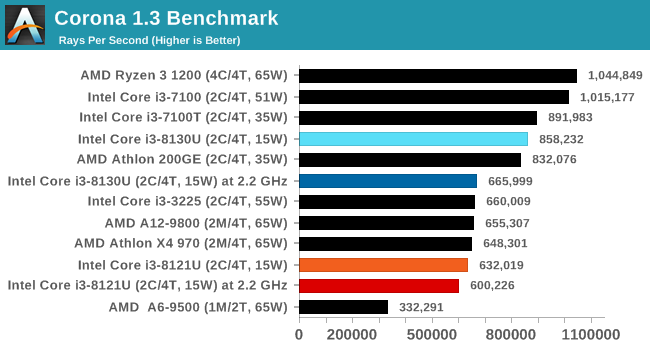
Corona is an AVX2 benchmark, and it would appear that the Cannon Lake CPU can't take full advantage of the functionality. There's still a 10% difference at fixed frequency.
Blender 2.79b: 3D Creation Suite
A high profile rendering tool, Blender is open-source allowing for massive amounts of configurability, and is used by a number of high-profile animation studios worldwide. The organization recently released a Blender benchmark package, a couple of weeks after we had narrowed our Blender test for our new suite, however their test can take over an hour. For our results, we run one of the sub-tests in that suite through the command line - a standard ‘bmw27’ scene in CPU only mode, and measure the time to complete the render.
Blender can be downloaded at https://www.blender.org/download/
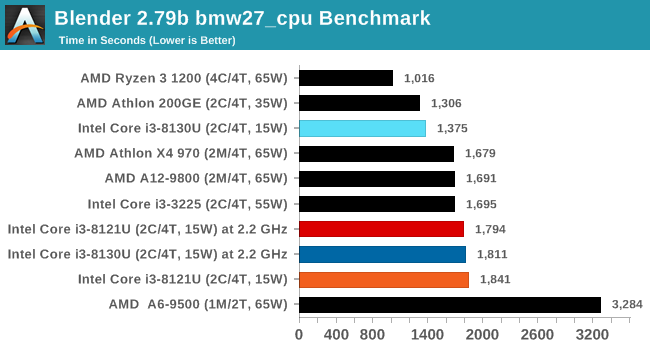
Blender also uses an AVX2 code path, and we see that the CNL processor scored worse at stock settings than at fixed frequency settings. Again, this is likely due to a power or thermal issue.
LuxMark v3.1: LuxRender via Different Code Paths
As stated at the top, there are many different ways to process rendering data: CPU, GPU, Accelerator, and others. On top of that, there are many frameworks and APIs in which to program, depending on how the software will be used. LuxMark, a benchmark developed using the LuxRender engine, offers several different scenes and APIs.
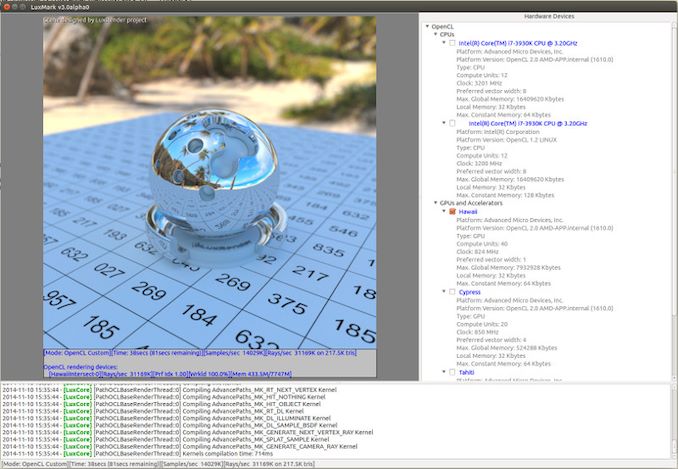
Taken from the Linux Version of LuxMark
In our test, we run the simple ‘Ball’ scene on both the C++ and OpenCL code paths, but in CPU mode. This scene starts with a rough render and slowly improves the quality over two minutes, giving a final result in what is essentially an average ‘kilorays per second’.
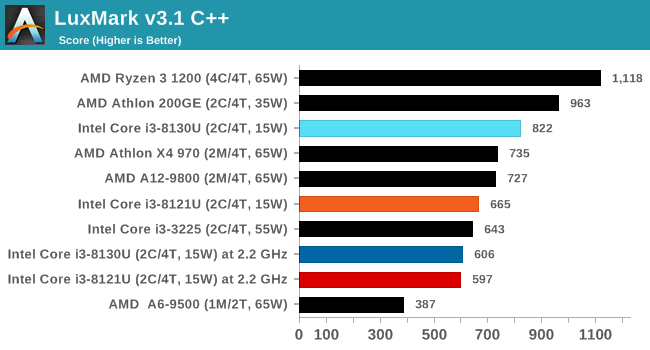
POV-Ray 3.7.1: Ray Tracing
The Persistence of Vision ray tracing engine is another well-known benchmarking tool, which was in a state of relative hibernation until AMD released its Zen processors, to which suddenly both Intel and AMD were submitting code to the main branch of the open source project. For our test, we use the built-in benchmark for all-cores, called from the command line.
POV-Ray can be downloaded from http://www.povray.org/
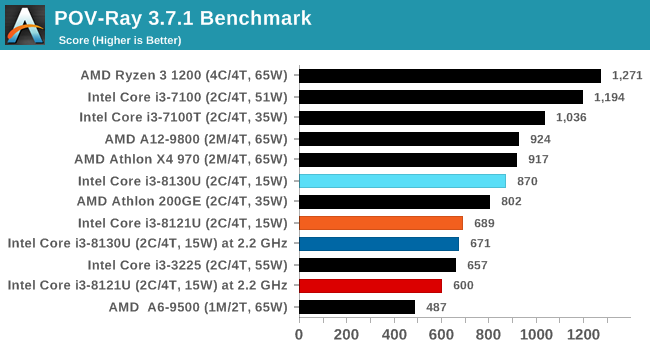











129 Comments
View All Comments
Gondalf - Friday, January 25, 2019 - link
For now they have nothing out in cpu departement, so i don't see any AMD bright year in front of us.I remember you we are already in 2019.
vegajf51 - Friday, January 25, 2019 - link
Icelake Desktop 3q 2020, intel will have another 14nm refresh before then.HStewart - Saturday, January 26, 2019 - link
Intel is expected to release 10nm+ with Covey Lake by Christmas seasons. This canon lake chip is just a test chip.pugster - Friday, January 25, 2019 - link
Thanks for the review. While the performance is not great, what about the power consumption compared with the 8130U?Yorgos - Friday, January 25, 2019 - link
it's not great obviously when you are stuck at 2.2GHz, while the prev gen cpu with the same capabilities(except the avx) can go up to 3.4GHz.I bet the 8130 would've been faster even if configured at 10Watt TDP.
Yorgos - Friday, January 25, 2019 - link
...and before jumping on me about that "stuck at 2.2GHz" let me report this:in certain loads the locked freq is slower than the unlocked one.
What does this mean? it most probably means that the unlocked freq makes the cpu run hot, throttle and then try to balance between temperature and consumption.
and a subnote on this. I think Intel should stop pushing the AVX instructions. It doesn't work as intended, it's not needed in most cases, especially when you have to design 256bit buses for 512bit data transfer on a low power cpu. Also it takes a lot of space on the die, it taxes the cache buses and it's useless when you disable your igpu(which is a good SIMD machine but not hUMA) and you have a dGPU up all the time just rendering your desktop.
They should try focusing on HSA/hUMA on their cpus+igpus instead of integrating wide SIMD instructions inside their cores.
0ldman79 - Saturday, January 26, 2019 - link
Thing is when AVX2 and AVX512 are used the performance increase can be rather massive.PCSX2, PS2 emulator, runs identically between my 3.9GHz Ivy Bridge Xeon (AVX) and my 2.8GHz i5 Skylake mobile (AVX2).
AVX2 makes several games playable. You can choose your plugin and the AVX plugin cannot play Gran Turismo 4 @ 2.8GHz, the AVX2 plugin can.
You may not find it useful, others do.
HStewart - Saturday, January 26, 2019 - link
It would be interesting to see the emulator re-factor to work with AVX 512 - it would like be twice the speed of AVX 2levizx - Sunday, January 27, 2019 - link
Nope, even with the simplest data set where AVX512 can perform twice the speed of AVX2 per cycle, the frequency has to drop significantly (~30% on Xeon Gold 5120 for example), so the upper limit is more like 40% gain. And that's PURE AVX512 code, you won't get that in real life. Assuming 50% AVX2 and 50% AVX512 code - that's a very generous assumption for non-datacentre usage, you'll have a 5% net gain.levizx - Sunday, January 27, 2019 - link
5%~20% net gain, depending on how the scaling works.